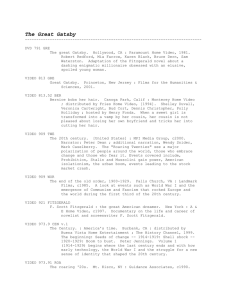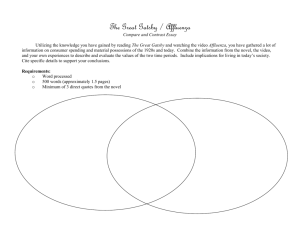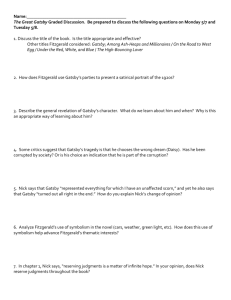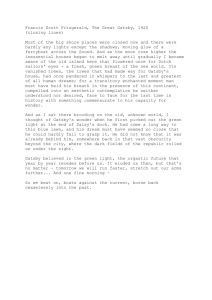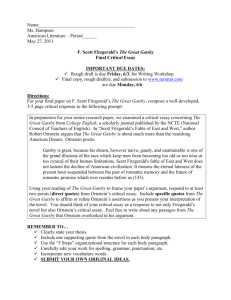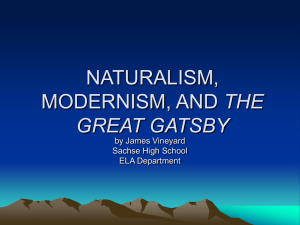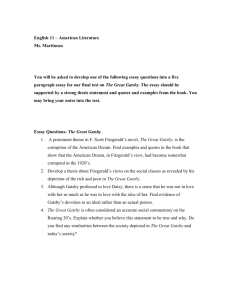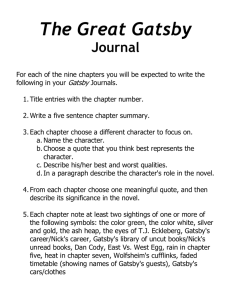RCT Gatsby Study Guide - Richmond Civic Theatre
advertisement
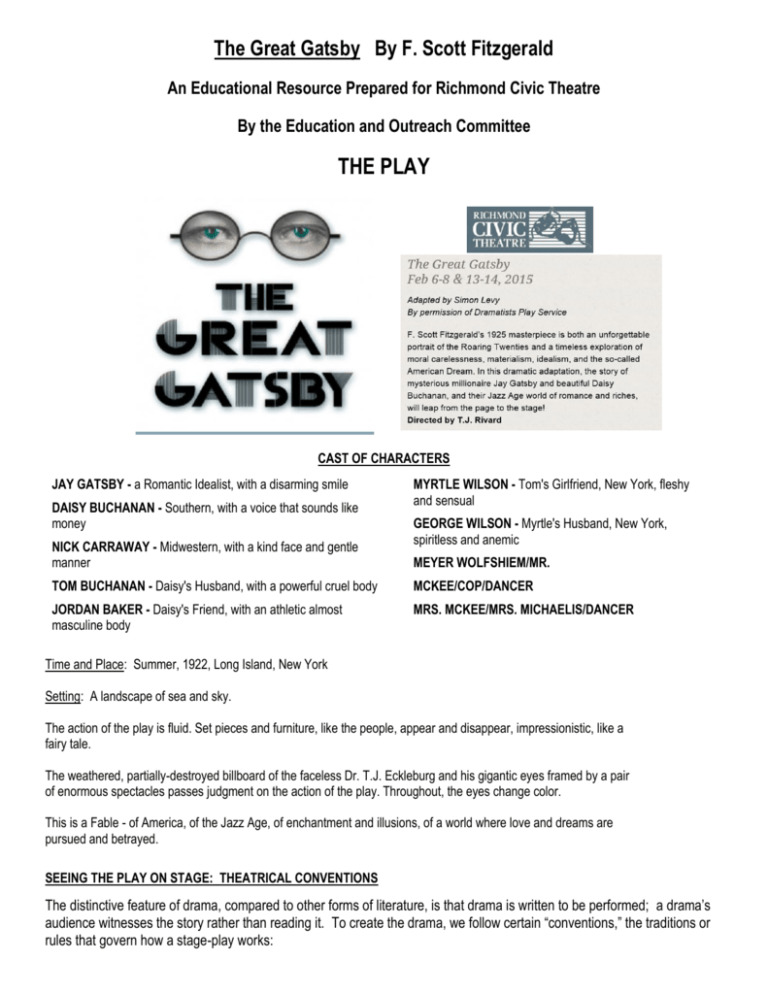
The Great Gatsby By F. Scott Fitzgerald An Educational Resource Prepared for Richmond Civic Theatre By the Education and Outreach Committee THE PLAY CAST OF CHARACTERS JAY GATSBY - a Romantic Idealist, with a disarming smile DAISY BUCHANAN - Southern, with a voice that sounds like money NICK CARRAWAY - Midwestern, with a kind face and gentle manner MYRTLE WILSON - Tom's Girlfriend, New York, fleshy and sensual GEORGE WILSON - Myrtle's Husband, New York, spiritless and anemic MEYER WOLFSHIEM/MR. TOM BUCHANAN - Daisy's Husband, with a powerful cruel body MCKEE/COP/DANCER JORDAN BAKER - Daisy's Friend, with an athletic almost masculine body MRS. MCKEE/MRS. MICHAELIS/DANCER Time and Place: Summer, 1922, Long Island, New York Setting: A landscape of sea and sky. The action of the play is fluid. Set pieces and furniture, like the people, appear and disappear, impressionistic, like a fairy tale. The weathered, partially-destroyed billboard of the faceless Dr. T.J. Eckleburg and his gigantic eyes framed by a pair of enormous spectacles passes judgment on the action of the play. Throughout, the eyes change color. This is a Fable - of America, of the Jazz Age, of enchantment and illusions, of a world where love and dreams are pursued and betrayed. SEEING THE PLAY ON STAGE: THEATRICAL CONVENTIONS The distinctive feature of drama, compared to other forms of literature, is that drama is written to be performed; a drama’s audience witnesses the story rather than reading it. To create the drama, we follow certain “conventions,” the traditions or rules that govern how a stage-play works: Actors pretend to be characters in the story. They perform words and actions that they have rehearsed for weeks, pretending all is happening for the first time. The audience members watch quietly as the play is performed, pretending that they are secretly witnessing the lives of these characters. Scenery, costumes, theatrical lighting, and other effects are used to create the setting. ____________________ 1. As you watch RCT’s production of The Great Gatsby, identify characters whose behavior on stage seems very “real” to you. (Maybe you almost forget you are watching an actor and believe this person’s words and actions are authentic.) After you’ve seen the play… A. Describe some moments in the play when the characters really seem to like and care about each other. B. Choose three characters from the play. Analyze what each person especially wants. (Sometimes in acting classes, this wish is called the character’s “spine”; in English class we might call it the “motivation.”) THE PLAYWRIGHT Simon Levy is the Producing Director for the Fountain Theatre in Los Angeles where he's been a resident playwright, director, and producer since 1993. His stage adaptation of The Great Gatsby, a Finalist for the PEN Literary Award in Drama, completes his Fitzgerald Trilogy, which includes Tender is the Night (Winner of the PEN Literary Award in Drama) and The Last Tycoon (winner of numerous awards and nominated for the prestigious Los Angeles Drama Critics Circle Ted Schmitt Award for Original Play). He's currently writing a film, The Wedding Dress, for Daniel Wilson Prods . , and creating the book for a new musical. His stage adaptation of Eliot Weinberger’s celebrated article, What I Heard About Iraq, has been produced worldwide, including the Edinburgh Fringe Festival (where it won the Fringe First Award); the Adelaide Fringe Festival (where it won the Fringe Award); was produced by BBC Radio; and received a 30-city UK tour culminating in London. He was recently honored with the Los Angeles Drama Critics Circle Milton Katselas Lifetime Achievement Award in Directing. He is the author of other plays, short stories and poems... and his directing and producing credits, along with his awards, are numerous. For more information, please visit www.simonlevy.com. THE AUTHOR Francis Scott Key Fitzgerald (September 24, 1896 – December 21, 1940) was an American author of novels and short stories, whose works are the paradigm writings of the Jazz Age, a term he coined himself. He is widely regarded as one of the greatest American writers of the 20th century. Fitzgerald is considered a member of the "Lost Generation" of the 1920s. He finished four novels: This Side of Paradise, The Beautiful and Damned, Tender is the Night and his most famous, The Great Gatsby. A fifth, unfinished novel, The Love of the Last Tycoon, was published posthumously. Fitzgerald also wrote many short stories that treat themes of youth and promise along with despair and age. - Wikipedia Links of Interest F. Scott Fitzgerald Society http://www.fscottfitzgeraldsociety.org/ F. Scott and Zelda Fitzgerald Museum http://www.fitzgeraldmuseum.net/ F. Scott Fitzgerald Quotes http://en.wikiquote.org/wiki/F._Scott_Fitzgerald THE NOVEL Reading Level 8.1 AR: 9.1 Lexile: 1070 The Great Gatsby, published in 1925, is widely considered to be F. Scott Fitzergerald's greatest novel. It is also considered a seminal work on the fallibility of the American dream. It focuses on a young man, Jay Gatsby, who, after falling in love with a woman from the social elite, makes a lot of money in an effort to win her love. She marries a man from her own social strata and he dies disillusioned with the concept of a self-made man. Fitzgerald seems to argue that the possibility of social mobility in America is an illusion, and that the social hierarchies of the "New World" are just as rigid as those of Europe. The novel is also famous as a description of the "Jazz Age," a phrase which Fitzgerald himself coined. After the shock of moving from a policy of isolationism to involvement in World War I, America prospered in what are termed the "Roaring Twenties." The Eighteenth Amendment to the American Constitution, passed in 1919, prohibited the sale and consumption of alcohol in America. "Prohibition" made millionaires out of bootleggers like Gatsby and owners of underground salons, called "speakeasies." Fitzgerald glamorizes the nouveau riche of this period to a certain extent in his Jazz Age novel. He describes their beautiful clothing and lavish parties with great attention to detail and wonderful use of color. However, the author was uncomfortable with the excesses of the period, and his novel sounds many warning notes against excessive love of money and material success. Fitzgerald's The Great Gatsby was not a great success during his lifetime, but became a smash hit after his death, especially after World War II. It has since become a staple of the canon of American literature, and is taught at many high schools and universities across the country and the world. Four films, an opera, and a play have been made from the text. (http://www.gradesaver.com/the-great-gatsby/study-guide/about ) http://www.woodstockctcafe.com/wp-content/uploads/2013/05/Travel-route.jpg Novel Study Guides http://www.gradesaver.com/the-great-gatsby (free samples are offered, complete guide is for sale) http://www.huffenglish.com/gatsby/gatsbystudy.pdf (includes study questions for each chapter) http://www.searchlit.org/novels/443.php#for_educators https://www.teachervision.com/novels/resource/2925.html http://www.discoveryeducation.com/teachers/free-lesson-plans/the-great-gatsby.cfm Indiana Academic Standards Related to the Study of The Great Gatsby Name: ________________________________________________ Date: _______________ THE GREAT GATSBY TREASURE HUNT (To be completed BEFORE reading the novel!) Go to the following website - http://www.huffenglish.com/gatsby/gatsbyhunt.html , an online treasure hunt authored by Valerie Arbizu. You will find questions and links relating to 12 different topics relevant to our study of The Great Gatsby by F. Scott Fitzgerald. 1. F. Scott Fitzgerald 2. World War I 3. 19th Amendment 4. The Roaring Twenties 5. 18th Amendment 6. Prohibition 7. Organized Crime and Arnold Rothstein 8. Flappers 9. Automobiles 10. Music 11. 1920s Slang 12. Video (Great Gatsby movies) Choose at least 4 of the topics (circle in the list above, please) and follow the directions in the treasure hunt for them. Answer thoroughly in complete sentences on your own paper. Do not “cut and paste”. Avoid Plagiarism. Rephrase the answers in your own words. Then, complete the directions for # 13 – Drawing Conclusions on the lines below. Based on the information you have collected from this website, what do you think the plot and setting of The Great Gatsby will include? What kinds of characters do you expect to encounter in the novel? _________________________________________________________________________________________________ _________________________________________________________________________________________________ _________________________________________________________________________________________________ _________________________________________________________________________________________________ _________________________________________________________________________________________________ _________________________________________________________________________________________________ _________________________________________________________________________________________________ _________________________________________________________________________________________________ _________________________________________________________________________________________________ _________________________________________________________________________________________________ BOOK OR PLAY – WHICH IS THE GREATER GATSBY? Name: __________________________________ Now that you’ve read The Great Gatsby by F. Scott Fitzgerald and seen the play adaptation by Simon Levy, let’s compare the two. Fill in the following chart comparing and contrasting them. (IAS RL.4.1) Compare – How were they the same? Contrast – How were they different? Characters Setting Plot Would you say that the play was faithful to the original text? Explain your answer, citing specific examples from the book and play. _________________________________________________________________________________________________ _________________________________________________________________________________________________ _________________________________________________________________________________________________ Does each version have the same impact on the audience? Explain your answer. _________________________________________________________________________________________________ _________________________________________________________________________________________________ _________________________________________________________________________________________________ Now, review the book and play. The Book The Play Which did you rate higher? Why? _________________________________________________________________________________________________ _________________________________________________________________________________________________ _________________________________________________________________________________________________ _________________________________________________________________________________________________

